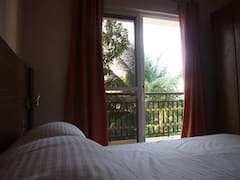The small city of Dumaguete in Negros Oriental proudly calls itself a university town because of the very first American university established in Asia - Silliman University. This quaint city has so much to offer: an interesting local history, good food and some of nature’s greatest wonders.
1. History lesson 1: the Dumaguete Belfry

The Dumaguete Belfry is a structure you will not miss in the center of the city. The imposing bell tower was built in 1811 and is the oldest one of its kind in the province and possibly even in the Visayas Islands. It was specifically constructed to serve as a warning beacon during the Spanish period, when Muslim groups would raid the island. The bell tower would sound the alarm when this would happen. Located in the city plaza, it is a witness to the transformation of Dumaguete from a small town to a bustling city. There is a small garden at the base of the belfry where religious folk can offer their prayers or light a candle.
Dumaguete Belfry
Address: Perdices Street, Dumaguete City
How To Access: Take a tricycle to the church. Most tricycles ply this route.
2. History lesson 2: the Dumaguete Cathedral

The Dumaguete Cathedral is also known as the St. Catherine of Alexandria Cathedral. This church is as historical as the belfry as both were constructed during the Spanish period. Built between 1754 to 1776, it is said to be the oldest stone church on Negros Island. As the main Roman Catholic Church in the area, this place can get crowded during Sundays. If you want to visit without the crowds, it is best you visit during weekdays. The cathedral is a few steps away from the belfry, along Perdices Street.
St. Catherine of Alexandria Cathedral (Dumaguete Cathedral)
Address: Perdices Street, Dumaguete City
Operating Hours: For more information on mass schedules, check Mass Schedules
3. History lesson 3: Silliman University - Silliman Hall

Dumaguete City is primarily a university town because of the presence of Silliman University. First established as Silliman Institute in 1901 by the Presbyterian Board of Foreign Missions, it was the first American university in the Philippines and in Asia. It is named after Horace B. Silliman, the philanthropist from New York. The most historic building on campus is Silliman Hall which was built in 1909 and reflects the 19th-century Eastern Stick Style of architecture, a precursor of Victorian style architecture. In the first hall is the Assembly Hall where most university events were held.
Silliman Hall
Address: Rizal Boulevard, Silliman University, Dumaguete City
How To Access: Take a tricycle from anywhere in the city and ask to be brought to the hall along Rizal Boulevard
Operating Hours: Office hours - 8am - 5pm
Website: Silliman University
You might be interested in these Airbnbs!
4. History lesson 4: the Silliman University Anthropology Museum

On the second floor of Silliman Hall, you will find the small but rich Silliman University Anthropology Museum. This was established by another American missionary who was also an expert in Anthropology. The museum’s collection includes archaeological artifacts dating back to 200 BC and ethnographic objects that show how ordinary people thrived throughout the centuries. To inquire about the museum and to arrange for group tours, you may call Connie P. Cadeliña on +63 9166805714 or +63 35226002 local 207.
Silliman University Anthropology Museum
Address: Rizal Boulevard, Silliman University, Dumaguete City
Operating Hours: 8:30am - 11:30am; 2:00pm to 4:30pm, Mondays to Fridays; weekends and holidays, by special arrangement
Fees: Regular entrance fee for weekdays, 1 USD per person; weekend rate is 2 USD
5. Shoot the breeze with the locals at the Boulevard

Locals call it the Boulevard, but its full name is Rizal Boulevard, named after the Philippine national hero Dr. Jose Rizal. This half-kilometer (quarter mile) long promenade faces the coast of Dumaguete and is an ideal place for picnics, a jog or brisk walk, or simply shooting the breeze with the locals. After dusk, the boulevard is filled with street food vendors, serving up snacks such as the famed balut and a local version of tempura. If you cannot take street food, there are several restaurants and cafes along the boulevard which serve up local and international cuisine. Because of a high number of expatriate retirees in the area, the local food scene is quite diverse. This site is open all hours.
Rizal Boulevard
Address: Rizal Boulevard, Dumaguete City
How To Access: Take a tricycle from any point in the city. No admission fees required
6. Get a feel of local culture: Chinese Bell Church
This colorful Taoist temple can be found in the village of Calindagan in the city. This area is past the southernmost end of Rizal Boulevard, thus the temple is also known as the old temple by the sea. The place has a serene and spiritual feel to it. Visitors can roam the temple grounds and see different Chinese architecture styles and designs. Since it is place of contemplation, it is a nice place to rest and refresh your soul. You can reach this temple by hiring a tricycle to take you.
Chinese Bell Church
Address: Calindagan, Dumaguete City
Operating Hours: 6am - 6pm Daily
7. Discover a different kind of underwater treasure: Apo Island

The famous Apo Island in Dauin, Negros Oriental is reached via Dumaguete City. The island is known for its pristine snorkeling and dive sites, and its friendly sea turtles. Because the island is part of a marine protected area, activities around the area are regulated and you cannot go snorkeling or diving without a local guide, who is usually a member of the local community. The boatmen who serve visitors as well are also from the community. The best activity you can do here is to swim with the turtles, something that will leave you breathless and in awe of these great creatures. Aside from this, you can explore the island’s beaches and reefs. You can opt to make Apo Island a day trip but overnight accommodations on the island are also available. For dive tours, you may contact any of the local dive resorts.
Apo Island
Address: Apo Island, Dauin, Negros Oriental
How To Access: From Dumaguete City, ride a Ceres bus heading south (Zamboanguita) and ask the driver to drop you off at the Malatapay Market. From Malatapay, you can take a public boat that goes to Apo Island or if you are a big group, hire a boat to take you. Once in Dauin, make sure to register at the local Bantay Dagat office.
Fees: Environmental fee - 2 USD per person; Swimming with the turtles guide fee - 6 USD
Traveler's tips
If your Apo Island trip happens to fall on a Wednesday, try to check-out the Malatapay Market, as this is the day where local farmers and livestock growers come to display their produce. I recommend eating in one of the many food stalls in the market, some even serve lechon. Try to order "kinilaw" - it's a Philippine ceviche. It is a personal favorite.
8. Catch a show at the Luce Auditorium

Silliman University also prides itself of its premiere cultural venue, the Claire Isabel McGill Luce Auditorium. This is the largest fully-functioning theater outside of Metro Manila which was built in 1975. It is named after the late wife of Henry Luce, of the Henry Luce Foundation. Considered as a center for Culture and Arts in the Central Visayas, it plays hosts to different theatre, music and dance events. You may check out the Facebook page of Silliman University for details on the shows.
Silliman University Claire Isabel McGill Luce Auditorium
Address: Luce Road, Silliman University, Dumaguete City
Contact Information: +63 35 422 6002
9. Eat local: try chicken inato and painit

Chicken inato is a local version of grilled chicken. The chicken is marinated with lemongrass, ginger, garlic, black pepper, vinegar, brown sugar and lime juice. The most famous inato restaurant is Jo’s Chicken Inato, a family run business that started out in Dumaguete and has expanded to other parts of the Visayas and Mindanao. Its first branch in the city is found along Silliman Avenue.
For breakfast, you can skip the usual hotel fare and go to the public market to eat at any of the painitan stalls. Common fare is a sticky millet grain delicacy called budbud kabog, which is served with hot native chocolate. You can also eat sticky rice with fresh slices of mango. The stalls are usually open early in the morning.
10. Around Dumaguete: Twin Lakes of Balinsasayao and Danao

A trip to the Twin Lakes of Danao and Balinsasayao will take you a day, but it’s well worth the trip. The lakes are located in the town of Sibulan which is 26.7 kilometers (16.6 miles) away from Dumaguete City. The easiest way is to book a tour from any of the local tour agencies such as Green Earth Tours. Balinsasayao is the most accessible of the two lakes - there is a cafe that serves as a view deck for the lake. You can do paddle boating or snorkeling here too. To get to Danao Lake, you can trek for an hour or so, or you can take a paddle boat to the other side of Balinsasayao, where it is easier to reach Danao.
Twin Lakes
Address: Sibulan, Negros Oriental
Fees: Entrance Fee – about 2 USD per person; Cottages rental - 1 USD; Paddle Boat - 6.50 USD for 6 people
Getting to Dumaguete
From Manila, several flights a day ply the Manila-Dumaguete route. You may also travel from Cebu City, via plane or via bus through Oslob. Don’t let Dumaguete’s quaintness fool you, the city has such a rich local history and culture and the best way to find out more about this is by mingling with the locals. As you enjoy every aspect of your trip, you will agree with what most people say - that the city is indeed home to a “gentle people.”
Traveler's tips
You can also rent a motorcycle to get you around the City. This is the most convenient and one of the mode of transportation used by the locals. And if you don't know how to drive and ride a motorcycle, you can also ride the tricycle (locally known as pedicab), another mode of transportation the locals use. And if you want to explore more of the nearby cities and towns, there are local buses with regular schedules going to other parts of Negros Oriental. You can also rent cars and vans if you want more convenience and ease.
History
Get Trip101 in your inbox
Unsubscribe in one click. See our Privacy Policy for more information on how we use your data






















Create an account to